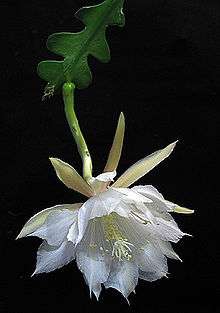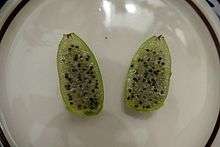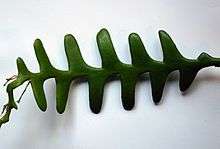Epiphyllum anguliger
| Zig Zag Cactus | |
|---|---|
 | |
| Photo: Emma Lindahl | |
| Scientific classification | |
| Kingdom: | Plantae |
| (unranked): | Angiosperms |
| (unranked): | Eudicots |
| (unranked): | Core eudicots |
| Order: | Caryophyllales |
| Family: | Cactaceae |
| Subfamily: | Cactoideae |
| Tribe: | Hylocereeae |
| Genus: | Epiphyllum |
| Species: | E. anguliger |
| Binomial name | |
| Epiphyllum anguliger (Lem.) G.Don | |
| Synonyms | |
|
Phyllocactus anguliger Lem. | |
Epiphyllum anguliger, commonly known as the fishbone cactus, is a cactus species native to Mexico. The species is commonly grown as an ornamental for its beautiful, fragrant flowers in the fall.
The fruit is delicious and is said to taste like gooseberries. The interior of the fruit looks rather like a kiwifruit, with green pulp and small black seeds.

Etymology
This species is named for its deeply toothed stems ("anguliger" = "angle bearing") which sometimes make a perfect rectangle.
History
This plant was first distributed by the Horticultural Society of London which obtained it from the collector, T. Hartweg, in 1846.
Origin and habitat
C & S Mexico (Jalisco, Nayarit, Colima, Guerrero, and Matanego). Epiphytic in evergreen oak forests.
Systematics
A very variable species but rather distinct and recognition of subspecific taxa seems unnecessary. Most closely related to Epiphyllum crenatum and Epiphyllum laui.
Cultivation
An easily cultivated, fast growing epiphyte. Needs a compost containing plenty of humus and sufficient moisture in summer. Should be kept at 16–25 °C (61–77 °F), it may drop to 10–15 °C (50–59 °F) for shorter periods. Best grown in semi-shade. Flowers in late autumn or early winter.
Description

Stems profusely branched, primary stems terete at base, often woody, apical part and secondary stems flat and rather succulent, 20–30 cm long, 3–5 cm wide, deeply lobed, often to near midrib, the lobes rectangular to obtuse or rounded; areoles small nude or with 1-2 white bristles; epidermis green, smooth. Flowers 6–20 cm long, 6–7 cm wide, nocturnal, strongly sweet-scented *; pericarpel with podarium; receptacle 8–16 cm long, 4 mm thick, pale yellow, greenish or pinkish, bracteoles few, minute, linear and green, adpressed; outer tepals 10, linear to linear-lanceolate, acute, spreading or reflexed, 4–5 cm long, lemon yellow to brownish yellow; inner tepals lanceolate to ovate, acute or acuminate, white, sometimes toothed, as long as outer tepals; stamens in two rows, white, erect to subdeclinate, nearly as long as tepals; style longer than inner tepals, white; stigma lobes 8-11, linear. Fruit ovoid, brownish, greenish or yellowish, 3–4 cm thick. {{http://www.plantsrescue.com/tag/epiphyllum-anguliger/|date=December 2016}}
Cultivars & hybrids
- 'El Tecolote' WC (REDC) 1997. E. anguliger x 'Bonanza Belle'. Inner tepals creamy white; outer tepals lemon yellow or golden bronze, similar to the species. Nocturnal, but stays open until noon the next day. Medium sized. Small, flat, deeply lobed stems.
- 'Jetz' WC (REDC) 1997. E. anguliger x 'Bonanza Bell'. Nocturnal fragrant flower with inner tepals cream, tips lemon yellow, acute and pencil line lemon yellow, ruffled margins, two next rows yellower, 4th and 5th rows solid lemon yellow; outer tepals bronze with yellow to red-orange midstripe. Overlapping wide form. Small plant with thick, flat stems, margins deeply lobed. (medium-large)
- 'What Luck'
WC (REDC) 1997. E. anguliger x 'Bonanza Belle'. Persimon orange, darker at edges, outer tepals rusty orange, overlapping, wide form. Style and stamens light orange. Flower medium-sized. Stems small, flat, deeply lobed.
- E. anguliger 'Beahmianum'
Collected by Thomas MacDougall in 1967, in Oaxaca, Mexico. Flowers white with a lavender-pink throat.
- E. anguliger 'Gertrudianum'
Flowers shorter than in most clones, 6-7,5 cm long and 12 cm wide. Strong grower and a prolific bloomer.

